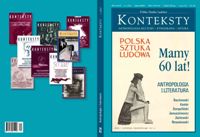Rapsod plemienny. Prywatne zapiski o sztuce Magdaleny Abakanowicz
Tribal Rhapsody. Private Notes on the Art of Magdalena Abakanowicz
Author(s): Aleksandra Melbechowska - LutySubject(s): Fine Arts / Performing Arts
Published by: Instytut Sztuki Polskiej Akademii Nauk
Keywords: Magdalena Abakanowicz; Polish sculpture; fine arts
Summary/Abstract: The numerous sculptures by Magdalena Abakanowicz (and her examples of related arts) include unusual visual concepts, meanings and contents relating to man’s individual and group experiences. Abakanowicz is interested in all that is alive: man, animal and plant, their diverse” bodies”, which she shapes or commemorates in anthropomorphic or biomorphic forms by using natural material, e. g. wool, canvas, jute, hide, horsehair, and wood but also stone and metal. The characteristic features of her works include monumentalism and a masterly treatment of ”mobile” textures which link the structures of the surface with the very core of a given composition. Abakanowicz is the author of highly unconventional fabrics known as Abakany; these by no means decorative or utilitarian objects comprise large-scale soft sculptures organising space. She finds the thread which ties together the structure of living organisms to be fascinating material. The human figures which are, as a rule, incomplete, maimed, naked, headless, armless, and sexually undefined (derived from the myth of Androgyne), are accompanied by Sitting Figures, Backs, Heads, Faces, Self-portraits and the figures and heads of animals. Hundreds of figures – swathed in sacking or cast in bronze – are arranged in rows and crowds against the backdrop of a panorama of large towns, in parks and gardens or on the banks of rivers and lakes. These “collective” compositions carry universal symbolic messages and speak about ”primary things” extracted from the depths of time; simultaneously, they are transposed into contemporary life and evoke a metaphorical image of the endless ”migration of the peoples”. Abakanowicz constantly resorts to the oldest motifs, such as the form of the circle. She executes round spoke constructions and rolled bearings, and in Israel arranges large circles composed of limestone in the Negev Desert. She also embarks upon the catharsis motif and depicts perennial War Games involving wounded human bodies and war machinery – guns and missiles, resembling toppled trees. Her Sarcophagi bring to mind coffins and the covers of nuclear reactors. Untamed imagination directs her towards architectural-town planning sculpture designed on an immense scale. Abakanowicz is the author of visions of plant-entwined houses-gardens intended for Paris and the 640-metres high Hand Monument, probably the loftiest statue in the world, stretched towards the sky and commemorating the victims of Hiroshima. Her entire oeuvre refers to the existential and spiritual condition of homo universalis and all cultures, at the same time becoming part of the ”correspondence of the arts” since the compositions resound with the echoes of musical rhythm or correspond to the visions of poets (T. S. Eliot) and architects (Hand Monument evokes the conception launched by Le Corbusier who half a century earlier executed a sculpture of The Open Hand raised towards the heavens in the Indian town of Chandigarh).
Journal: Konteksty
- Issue Year: 2007
- Issue No: 01
- Page Range: 105-109
- Page Count: 5
- Language: Polish
- Content File-PDF

